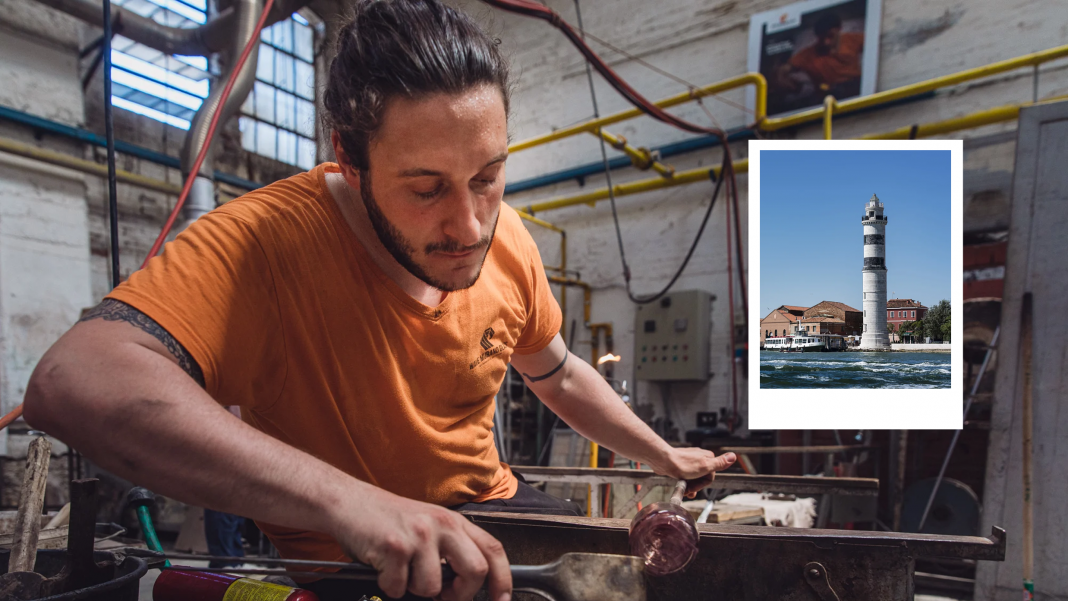From a physics student in Boston to one of Murano’s youngest master glassmakers, Roberto Beltrami’s remarkable journey blends scientific curiosity with artistic mastery. His passion for the ancient craft of glassblowing, combined with a drive to innovate and revive a struggling industry, is helping to breathe new life into Murano’s centuries-old traditions while inspiring a new generation of artisans.
A serendipitous discovery of glass art

Born in Brescia, Italy, just a few hours from the legendary glassmaking island of Murano, Roberto Beltrami’s path to becoming a master glassmaker was anything but predictable. It wasn’t until 2011, while studying physics at Boston University, that Beltrami first encountered the mesmerizing art of glassblowing. Captivated by an exhibition of Dale Chihuly’s work — the American artist known for pushing the boundaries of glass artistry — Beltrami found himself drawn to the medium’s vibrant colors, transparency, and fluid shapes.
On a summer trip back to Italy, he took a glassblowing class on Murano, which quickly turned into an apprenticeship. What started as a brief exploration became a full-time commitment and Beltrami left university behind to immerse himself in the island’s centuries-old workshops. Under the tutelage of some of Murano’s most revered masters, he traded lecture halls for furnaces, dedicating himself to mastering this demanding craft.

Preserving tradition while challenging the status quo
Murano’s glassmaking heritage spans over 700 years, a history rich with innovations like cristallo — the world’s first clear glass. However, the island’s industry has faced modern challenges: the number of active factories has dwindled, and young artisans have been reluctant to embrace the tough, manual labor that glassblowing demands. Beltrami experienced firsthand the resistance of established workshops, where secrecy and fear of job competition often barred newcomers from learning.

Undeterred, Beltrami founded Wave Murano Glass in 2017, becoming one of the youngest master glassmakers on the island. With a team predominantly under 35, his workshop is reviving the craft among a new generation, blending respect for tradition with fresh energy. “The average age is definitely under 35 — which is unheard of in Murano,” he notes, signaling a hopeful future for the craft.
The science and art of glassmaking
Glassblowing is a fascinating fusion of chemistry, physics, and artistry. It begins with melting sand, soda ash, and limestone at temperatures near 1,600°C (2,912°F). The molten glass is then shaped quickly by blowing, swinging, and rolling while it’s still pliable. This intricate process requires teamwork: one person rotates the pipe, another shapes the glass, and others may apply heat or decorations — all moving in coordinated rhythm.

Murano’s signature lies not only in technique but also in its pioneering use of color. Each pigment — cobalt for blues, lead for yellows, tellurium for pinks — responds differently to heat, making it a challenge to combine colors without cracking. Murano’s mastery of this delicate chemistry is part of what makes its glassware so unique and prized worldwide.
Modernizing an ancient craft
At its peak in the 16th century, Murano was home to tens of thousands of residents and hundreds of workshops. Today, only around 4,000 people live on the island, with fewer than a third involved in glassmaking. The industry faces stiff competition from mass-produced imitations flooding tourist shops, threatening both local artisans and Murano’s global reputation.
Beltrami is addressing these challenges head-on by introducing modern technology to his workshop. His furnaces are energy-efficient, capturing lost heat and reducing gas consumption by 80%. This blend of innovation and tradition allows Wave Murano Glass to produce everything from unique pieces to small batches of up to 1,200 items — filling a gap between large industrial runs and bespoke creations.
Inspiring the next generation
Beyond production, Wave Murano Glass also fosters education and outreach. Around 10% of the company’s revenue comes from classes and tours, inviting the public to experience glassblowing firsthand. Beltrami actively recruits young talent globally, including women — a group historically underrepresented in this demanding field.
For Beltrami, the preservation of Murano’s glassmaking legacy depends on nurturing new artisans who respect the craft’s deep history while embracing innovation. “The craftsmanship, the tradition of over a thousand years of history, all make it very special,” he reflects. His journey from physics student to master glassmaker is not just a personal achievement but a beacon of hope for Murano’s centuries-old art form.



